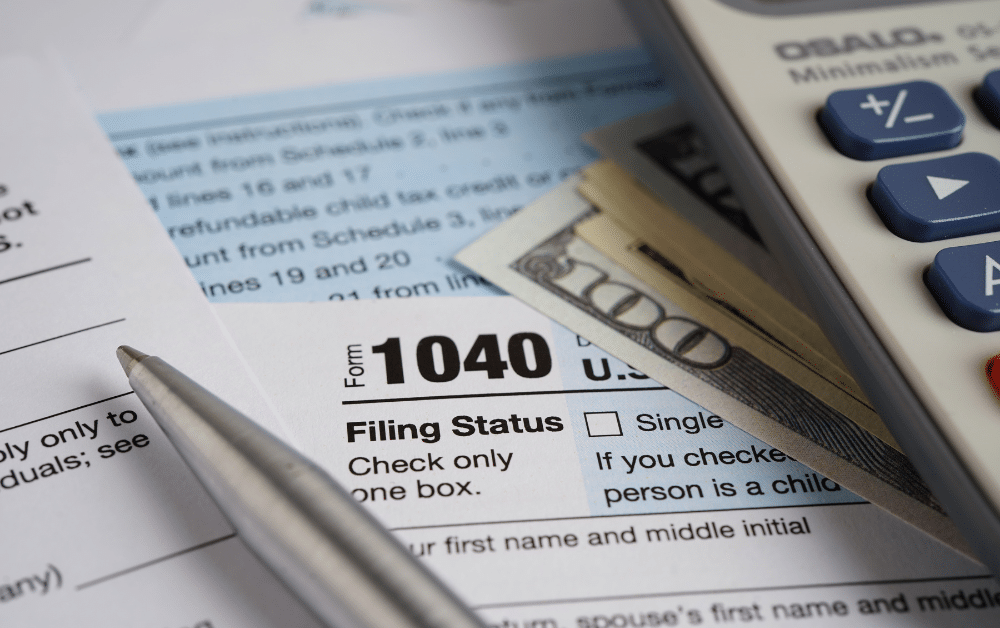Estimated Tax Payments for US Expats: Rules, Deadlines & More

- Who Is Required to Make Estimated Tax Payments?
- Do I Need to Pay Estimated Taxes While Living Abroad?
- How Much Should I Pay in Estimated Taxes?
- Estimated Tax Due Dates
- What Is the Underpayment Penalty for Estimated Tax Payments?
- How Can I Avoid the Underpayment Penalty?
- How to Pay Estimated Taxes with Form 1040-ES
- Estimated Tax Payments Can Be Confusing … How About a Little Help?
Every US citizen is required to file an annual tax return, even while living overseas. In addition to this, some expats have to estimate and pay taxes throughout the tax year. In this guide, we’re going to look at the requirements and options for estimated tax payments.
Key Takeaways
- Expats who expect to owe at least $1,000 after filing their tax return are required to make estimated tax payments throughout the year—or face an underpayment penalty.
- Expats should use the worksheet in the instructions for IRS Form 1040-ES to calculate estimated taxes.
- Estimated tax payments can be made online, over the phone, or through the mail.
Who Is Required to Make Estimated Tax Payments?
If you receive income that does not have tax withheld at the source, you may be required to make estimated tax payments. This includes individuals who are self-employed, receive employment income from a foreign employer who does not withhold US taxes, or have significant investment income.
In general, if you expect to owe $1,000 or more in taxes for the year, you should be making estimated tax payments. The IRS requires that estimated tax payments be made throughout the year, typically in four equal installments. These payments are due in April, June, September, and January of the following year.
It’s important to understand that failing to make estimated tax payments can result in penalties and interest charges. The IRS uses a complex formula to calculate these penalties, which can vary depending on the amount owed and the number of days late.
To avoid penalties, it’s essential to keep track of your estimated tax payments and work with a qualified tax professional service like Greenback, which can help ensure that you are meeting your obligations.
Dreading the last minute scramble pulling together your tax documents? Despair no more! This simple checklist lists the documents you need to have on hand when preparing to file.

Do I Need to Pay Estimated Taxes While Living Abroad?
The rules for paying estimated taxes are the same regardless of whether you live in the US or abroad. Specifically, you must make estimated tax payments if you expect to owe at least $1,000 when you file your annual tax return. You will need to be proactive in determining this since the IRS won’t inform you of this obligation until after you’ve failed to comply.
For example, if you earn your full-time income as a self-employed business owner, you will almost certainly need to make estimated tax payments during the year. You will do this by estimating your tax liability for each financial quarter and then submitting payment to the IRS by the appropriate deadline. If you wait until you file your tax return to pay what you owe as a lump sum, you will likely have to pay an underpayment penalty.
Of course, as an expat, you may not owe anything on your income at all. The IRS provides a variety of tax benefits for Americans living overseas, such as:
By using these benefits, many expats can reduce their US tax bill to less than $1,000—or erase it entirely. In that case, you would not be obligated to make estimated tax payments while living abroad.
Who doesn’t love a tax break? Download our easy-to-use excel calculator to get an estimate of how the foreign earned income exclusion can save you money.

How Much Should I Pay in Estimated Taxes?
If you are required to pay estimated taxes, you will need to calculate what you owe. Estimating your tax liability may be simple or complicated, depending on the details of your income. If you expect to owe the same amount that you did last year, then you can divide that number by four and submit one division per financial quarter.
Let’s look at an example. In late 2023, Sarah Expat moved to Japan to work for a Japanese IT company. Because her foreign employer doesn’t deduct US taxes from her salary, she is responsible for paying her own tax bill. Last year, Sarah owed $30,000 in US taxes. Since nothing about her income has changed since then, she expects she will owe roughly the same amount for the 2024 tax year.
So, Sarah divides her estimated $30,000 tax bill by four and pays one division each quarter. This means that her quarterly estimated tax payments are $7,500 each ($30,000 ÷ 4 = $7,500.)
If your tax situation has changed since your last tax bill, you will need to perform some more complex calculations:
- First, estimate your income for the full year.
- Then, determine what taxes will apply to that income and at what rates. (This may include the self-employment tax as well as the income tax.)
- Factor in any deductions, credits, or exclusions available to you.
- Estimate your final tax debt for the year.
- Divide the amount you expect to owe into four parts to cover your quarterly estimated tax payments.
Alternatively, you can calculate your income and tax liability for each individual quarter. The quarterly payments do not have to be equal. This may be the best option if your income fluctuates throughout the year.
Consider opening a separate savings account for your taxes. As you receive income, you can set a percentage of it aside for your estimated tax payments. For example, if your tax bill is typically 30% of your income, deposit 30% of all income you receive into your dedicated savings account. This will simplify your calculations and ensure you have the money ready when it’s time to pay.
Estimated Tax Due Dates
Estimated tax payments are due on a quarterly basis. In the table below, you can see the due dates for each financial quarter for the 2024 tax year (filed in 2025).
| Financial Quarter | Taxable Period | Due Date |
| Quarter 1 | January 1 – March 31 | April 15, 2025 |
| Quarter 2 | April 1 – May 31 | June 16, 2025 |
| Quarter 3 | June 1 – August 31 | September 15, 2025 |
| Quarter 4 | September 1 – December 31 | January 15, 2026 |
You can also opt for a monthly payment schedule if you prefer. To do this, calculate and submit payments at your preferred cadence throughout the year.
What Is the Underpayment Penalty for Estimated Tax Payments?
Taxpayers who fail to submit estimated tax payments when required are subject to an underpayment penalty. This penalty is not applied as a static percentage or flat fee. Rather, it will vary based on the following:
- The total amount of unpaid taxes
- The time of delinquency between the due date and payment
- The interest rate for the period in which the taxes were due
The total penalty is capped at 25% of the unpaid amount. The IRS will notify delinquent taxpayers of this penalty after they file their annual tax returns. This penalty will accrue interest until it is paid in full.
You can use IRS Form 2210 to determine if you owe the underpayment penalty and, if so, how much the fine will be. This will allow you to pay the penalty immediately without accruing further interest.
How Can I Avoid the Underpayment Penalty?
Because estimated tax payments are just that—an estimate—it may seem impossible to know exactly how much you will owe. So how can you be sure you’re paying enough? This is especially problematic for taxpayers whose annual income fluctuates unpredictably.
The good news is that the IRS gives some leeway for underpayment. You don’t have to pay 100% of what you owe. As long as you pay at least 90%, you will not be charged the underpayment penalty. If even that seems too risky, the IRS offers another option. If you pay 100% of the previous year’s tax debt (or 110% for high-income-earning individuals), you will not be charged with underpayment.
For example, if you paid $15,000 in taxes last year, you will not be charged an underpayment penalty as long as you pay at least $15,000 in estimated taxes for the current year—even if your final tax debt ends up being higher than that. Of course, you will still need to pay any unpaid taxes when you file your annual return, but you will not be subject to the additional penalty.

How to Pay Estimated Taxes with Form 1040-ES
You will use the worksheet in IRS Form 1040-ES to calculate and pay your estimated tax. You have a few options for submitting payment.
1. Paying Estimated Taxes Electronically
Submitting your estimated tax payments online by direct bank transfer is generally the easiest and safest choice. Plus, you’ll be able to access your payment history more easily when you file your expat tax return.
The IRS offers several options for paying your estimated taxes online. For most people, the simplest option is the Electronic Federal Tax Payment System (EFTPS). Enrolling is easy—registration usually takes no longer than ten minutes. However, after enrolling, you will have to wait for a PIN number to arrive by mail.
2. Paying Estimated Taxes by Phone
Estimated tax payments can also be made over the phone using a debit or credit card. This will mean calling one of the following IRS-approved payment services:
You can find the phone numbers for these services on page four of the instructions for Form 1040-ES.
3. Paying Estimated Taxes via Mobile
To pay estimated taxes via mobile phone, download the IRS2Go app and follow the instructions provided.
4. Paying Estimated Taxes by Mail
You can pay your estimated taxes by attaching a check or payment voucher to your completed Form 1040-ES and mailing both to the appropriate IRS address. The IRS does not recommend this approach. To learn more, refer to page four of the Form 1040-ES instructions provided on the IRS website.
5. Paying Estimated Taxes with Cash
You can submit cash payments in person at certain retail partners. To do this, you must be registered online with ACI Payments, Inc. There is a transaction limit of $1,000 per day, so amounts greater than this would have to be split up over multiple days. The IRS advises that you should never send cash payments through the mail.
Estimated Tax Payments Can Be Confusing … How About a Little Help?
After reading this guide, you should have a better understanding of how and why you might need to make estimated tax payments as an expat. If you still have questions, we have the answers.
At Greenback Expat Tax Services, we specialize in helping Americans around the world manage their US tax obligations. Just Contact us, and we’ll be happy to help you in any way we can. In fact, we can even prepare and file your expat taxes ourselves.



